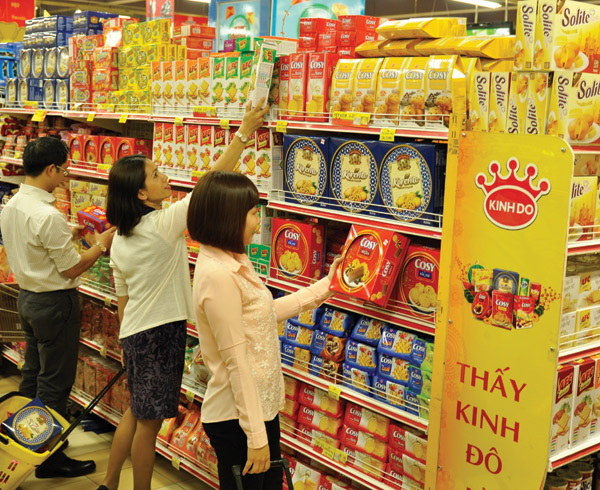Confectionery firms compete for $1.76-billion market
 |
| The confectionery market is growing more active as the Lunar New Year approaches |
A competitive market
The Vietnamese confectionery market is said to grow slowly. It grew by 8-10 per cent in the last two years, while it was 15-20 per cent in 2010-2015 and 35 per cent in 2006-2010.
Vietnam’s 90-million market is attracting foreign investors. As it grows far faster than the global confectionary market (1.5 per cent), and the Southeast Asian one (3 per cent), according to statistics of Vietinbank Securities JSC.
Lotte, one of South Korea’s largest groups is constantly expanding its market share in Vietnam. Mondelez International, one of the leading fast food corporations spent VND8 trillion ($352.5 million) buying 80 per cent of Kido’s total shares and intends to buy the remaining 20 per cent.
Setting foot into the Vietnamese confectionery market, the $64-billion-capitalisation foreign giant will make this market more competitive.
According to Truong Phu Chien, director general of Bibica, each country needs a flagship domestic brand to compete with global brands. Earlier, Bibica was eyed by various foreign firms.
The Lotte-Bibica-PAN Group trio was a hot topic on the confectionery market. In 2008, Lotte bought over 30 per cent of Bibica and intended to raise its ownership further. However, PAN Group butted in 2015, raised its ownership in Bibica to 50.07 per cent in 2017, and became the dominant shareholder.
According to BMI, the revenue of the Vietnamese confectionery market was VND27 trillion ($1.2 billion) in 2014, and is expected to reach VND40 trillion ($1.76 billion) in 2018. Thereby, domestic and foreign firms have been constantly releasing new products and competition strategies.
Particularly, the Orion brand has been very successful as it suits Vietnamese taste and had good marketing campaigns. Thus, the revenue of Orion Vina Co., Ltd. hit over $174 million in 2016 through this product.
Pham Nguyen Foods released Choco P&N and Phaner Pie at a low price and started distribution at 12,000 retail points. Over 17 million pieces were consumed per month.
Bibica also joined the market with Mini Pie Orienko in April 2017 and targeted to capture 20 per cent of the market.
Vietnamese confectionery looking for a place
Despite competition with foreign products, Vietnamese consumers are paying more attention to domestic confectioneries due to their improving quality, good looks, and good marketing campaigns.
Nguyen Huu Minh, a banking officer, told that he will buy Goody (a Bibica product) instead of Danisa (made in Denmark), along with some fruit jams made in Vietnam for this Lunar New Year.
Many Vietnamese brands are springing up on the market, especially processed fruits, dried fruits, and jams receive attention. Experts assess that the gap between the quality of domestic and foreign confectionery is not large.
According to the master plan for processed foods by 2020 with a vision to 2030, proportion of confectionery in the total processed foods is increasing. Particularly, the market will reach an output of 2.2 million tonnes, capturing 40.43 per cent of the total processed foods market.
There are opportunities for all, but firms that can proactively innovate and provide suitable products for consumers will net the largest market share.
| Bibica becomes official PAN Food subsidiary PAN Food Manufacturing JSC (PAN Food) successfully acquired more than 50 per cent of Bibica Corporation (Bibica)’s stakes, overtaking Lotte Confectionery Co., Ltd. (Lotte) as the biggest shareholder and turning Bibica into a subsidiary. |
| Japanese fund invests in Vietnamese confectionery company A Japanese institutional investor, Mizuho ASEAN Investment LP, has invested US$9.3 million in Phạm Nguyên Confectionery Company Ltd. |
| Lotte becomes the main shareholder of Bibica Lotte Confectionery Co., Ltd. (Lotte) is now the main shareholder of Bibica Corporation (BBC) after its main counterweight SSI sold its entire holding. |
What the stars mean:
★ Poor ★ ★ Promising ★★★ Good ★★★★ Very good ★★★★★ Exceptional
Latest News
More News
- Businesses ramp up production as year-end orders surge (December 30, 2025 | 10:05)
- Vietjet chairwoman awarded Labour Hero title (December 29, 2025 | 13:06)
- How to unlock ESG value through green innovation (December 29, 2025 | 10:03)
- AI reshapes media and advertising industry (December 29, 2025 | 08:33)
- FPT and GELEX sign deal to develop blockchain tech for global markets (December 29, 2025 | 08:29)
- Vietnam’s GDP forecast to grow by 9 per cent in 2026 (December 29, 2025 | 08:29)
- Women entrepreneurs are key to Vietnam’s economic growth (December 29, 2025 | 08:00)
- Vietnam's top 500 value-creating enterprises announced (December 27, 2025 | 08:00)
- The PAN Group shaping a better future with ESG strategy (December 26, 2025 | 09:00)
- Masan Consumer officially lists on HSX, marking the next phase of value creation (December 25, 2025 | 13:20)




















 Mobile Version
Mobile Version